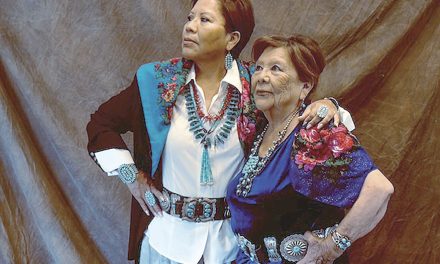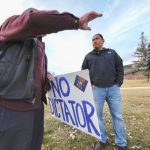
Letters: Inspired by Ahasteen cartoon, Krisst article
I was inspired to write this when I saw in the May 6 edition Jack Ahasteen’s editorial cartoon on Page A6, and Rima Krisst’s article, which begins on Page A8.
I was reminded of the summer of my eighth year, when my family vacationed in a state park in the Appalachian Mountains, where cabins were crudely configured to represent a “tipi” at their entrances.
From age 13 to 16, my Saturday afternoons were often occupied in a movie theater where for 15 cents I watched a double-feature movie, one of which was invariably a “western” in which the cowboys or cavalry always defeated the Indians.
It should be easy to see how these experiences sullied my mind by implanting a twisted picture of the descendants of the earliest inhabitants of the Americas.
My education through grade 12 was in public schools of the rural South. When my father was stationed at Quantico Marine Corps Base in Virginia, I attended an on-base school. On the first day of school, a Black boy, my age (seven or eight at the time), boarded the school bus at a stop in the base-housing complex. There was an empty seat next to me and I invited him to sit. We introduced ourselves and chatted during the trip to school. I remember distinctly saying I would save a seat for him the next day.
That day never came. When the bus reached the stop where he stood, I opened the window and waved to him. He turned away, but did not board the bus. I learned from children’s gossip that he and other Black children would not attend school with us. Although the Marine Corps had been integrated by order of President Truman, the laws and prejudices of the people of Virginia were enough to overcome even a presidential order.
I have never forgotten this incident nor the lesson I learned from it. I never will. I hope by sharing this story I may help others turn away from unreasoned prejudice.
Paul Lentz
Peachtree City, Ga.
Replace NHA, NTEC boards, CEOs
Lately, Navajo boards and their CEOs have been in the news. This is nothing new for the Navajo Nation.
The one thing everybody should understand is that being a CEO or a board member is not a permanent position. Individuals that get appointed to those positions are there temporarily. Too often board members and CEOs on Navajo think those positions are permanent positions.
The tribe has to put its foot down and make changes when boards and CEOs are not performing or meeting the people’s expectations.
Today we have two tribal entities that the people and the leadership are not happy with. One is Navajo housing and the other is Navajo Transitional Energy Company.
Why do boards and CEOs feel they are entitled to continue when the tribe does not feel the entities are providing to its people? Why do we allow them to continue even when they are not performing or delivering?
As Navajo Nation struggles to make sure that its entities are performing and delivering to the tribe, we find that these CEOs and board members do not like being held accountable. They enjoy the huge salaries and stipends, but do not want to be questioned.
One solution is to have oversight be made up of other professionals that understand the business and can make recommendations back to the lawmakers. These oversights can also red-flag issues that the lawmakers can later question.
Off the reservation, CEOs and board members that do not perform are removed immediately, often with no recourse because they are under contract or appointed.
Here on Navajo, board members and CEOs want to continue even if they are not performing or delivering. Many CEOs will never do what’s in the best interest of the Navajo people.
There are many people that can sit on these boards and be CEO. What board members and CEOs convince others is that if they are removed the whole organization will stop or fail. That is a typical fear tactic that many of them use here on Navajo. We have to be smart enough to understand that, that just isn’t true.
There are many professional people that can step in and be good board members, as well as good CEOs. It is time to make changes at both Navajo Housing Authority and Navajo Transitional Energy Company. Enough said on this matter — just fix the entities.
Samuel Begay Sr.
Shiprock, N.M.
Are we celebrating the right birthday?
My name is Lynn Hatch. My brother Karl and I went to school with Kenneth Tataushon (I’m sure that is not the correct spelling). I’m guessing late ’50s or early ’60s.
Kenneth was part of the LDS churches foster program. He lived with the Stutsnagger family in Washington Terrace, Utah.
I and my friends and family celebrate his birthday on May 10th. I am not sure where I came up with that date, but it is the day that I choose.
Kenneth, if you read this, please contact me at 541-410-5087 or email me at wlhatch@hotmail.com.
Karl and I are curious how you are doing and to find out if that is your real birthday.
Lynn Hatch
LaPine, Ore.
War veteran serves as first Navajo Policeman
Long ago, in a place that is in the northeast direction of the Tonalea General Store, Highway 160, an up-to-date store was unpopulated.
In late 1895, the late John Daw created the first settlement of the area near Black Mesa, also known as John Daw Mesa.
Recognized as being a courageous war hero and an expert marksman, the late John Daw served with the Armed Forces of the United States, Troop L, Second Regiment of Cavalry, who enlisted May 7, 1891, at Fort Wingate, New Mexico.
He was honorably discharged from the Army of the United States on Dec. 5, 1894.
Cavalry is a unit of soldiers mounted on horseback. During the Middle Ages, only knights and their squires fought on horseback.
Later, common soldiers rode horses to the battlefield, then dismounted to fight.
During the Indian War in America, which began in colonial times and lasted late 1900, disputes over the rich lands in uranium, natural gas, coal, and oil are natural products caused most of the fighting between North American Indian warriors and early white settlers.
The late John Daw was assigned to the U.S. Army, Second Cavalry, where he served from 1891 to 1894. He was frequently chosen as a squad leader to lead cavalry soldiers in battle.
North American Indian soldiers were responsible for the defense of their lands. American Indians were the first people to live in the Americas. They had been living there for thousands of years before any Europeans arrived.
John Daw lived from 1869 to 1971. He was a Navaho shaman who were sometimes called medicine man and considered by North American Indians to have close contact with the world spirits.
After John Daw was honorably discharged, he became a member of the Navaho Police and patrolled and defended the frontier on horseback and were the first form of the Navaho Police during the 1900s.
John Daw, earning the nickname of “Silao Tsoh,” meaning “Big Policeman,” or “Soldier,” who was an ancestor of the late Jerry Lorenzo Daw. They were Army … fearless.
A Vietnam War hero, the United States Army’s Jerry Lorenzo Daw who served as a corporal with Army Paratroopers, 101st Airborne Division, 2nd Battalion, 327th Infantry Troopers.
Jerry Lorenzo Daw was a Navaho Indian, killed in the Vietnam War on June 8, 1967, who paid the ultimate sacrifice in defense of freedom, and who had served honorably in the armed forces.
“Freedom has always been worth fighting for.”
Floyd Dawson
Tonalea, Ariz.








 Highway 264,
Highway 264, I-40, WB @ Winslow
I-40, WB @ Winslow